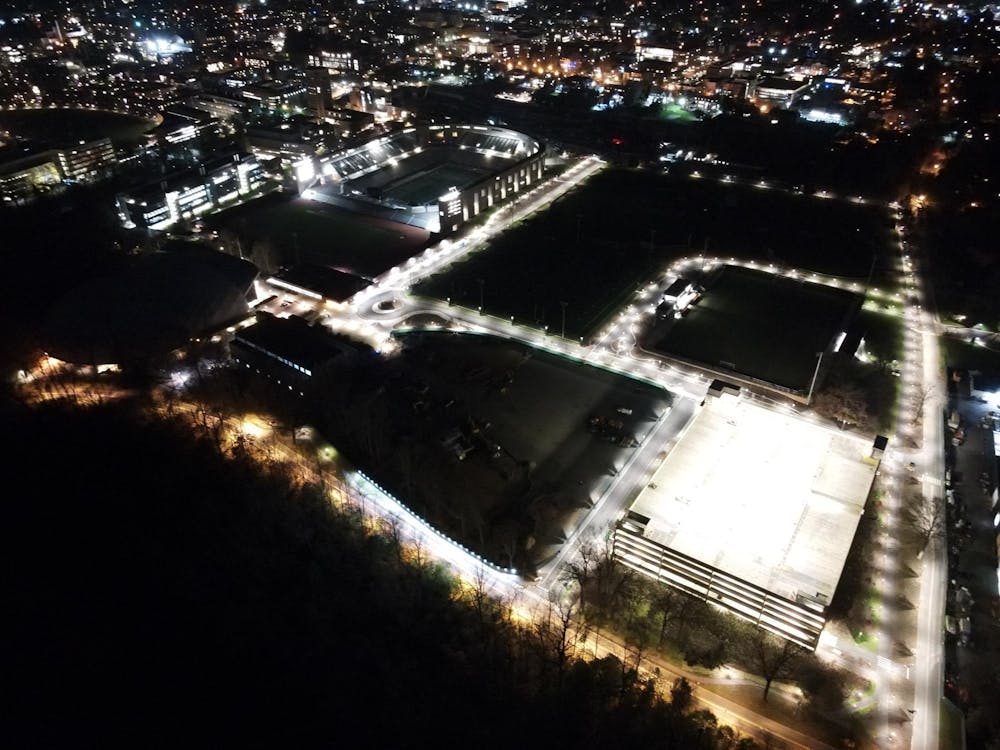The sky in Princeton shone brightly on the night of Friday, Sept. 29, with a noticeable purple hue around campus.
The unusual sight startled many onlookers, some of whom speculated the source to be fireworks and bright lights coming from Princeton Football’s comeback victory against Ivy League-opponent Columbia University. The hue was a more extreme example of light pollution — defined as the “excessive or poor use of artificial outdoor lighting“ by National Geographic. This has been a recurring issue on the University’s campus.
The issue was recently investigated by Gáspár Bakos, a professor of astrophysical sciences, through a campus survey. According to its description, “aerial monitoring [was used] to map the night-time illumination of campus to identify areas where steps can be taken to reduce the amount of light escaping into the night sky.” The project is a continuation of a junior project conducted by Nicholas Barton ’16.
Bakos has been monitoring light pollution since he arrived at the University in 2011.
In a written statement to the ‘Prince,’ Bakos revealed that “stray photons,” which cause the visual effects like those seen on Friday, are the result of “the design and implementation of [Princeton’s] outdoor lighting, [which is] lagging far behind eco-friendly standards.”
“I estimate that about 60 [percent] of our campus photons are wasted, either [by] being excessive, misdirected, or obtrusive,” Bakos said. “No street light should be visible from 100 meters, let alone from above, [and] no stray light should shine through any of the dormitory windows,” he added.
According to Bakos, light pollution on campus is increasing at a “very steep rate” and has “doubled” over the last decade. This change corresponds with national trends; according to a study published in the journal Science that examined the change in sky brightness over time, “the average night sky [has increased in brightness] by 9.6 [percent] per year from 2011–2022, which is equivalent to doubling the sky brightness every eight years.”
Light pollution is not without consequences. According to DarkSky International, a non-profit organization committed to education on light pollution and related changes, artificial light time exposure at night affects health by disrupting the circadian rhythm and suppressing melatonin production, and the glare from outdoor lighting can decrease vision by reducing contrast. Furthermore, the effects on melatonin production have been “clearly linked with depression, diabetes, and various types of cancer, particular[ly] breast cancer,” according to Bakos.
“Given our highly intellectual environment, and our mission to teach and learn, [the importance of these adverse health effects] should be kept in mind,” stressed Bakos.
Wellbeing of those on campus is not so straightforward, however. At the same time as Bakos warns of excess light, students have been asking for more lighting on campus as a safety measure, citing a lack of visibility when using pathways at night. In particular, the increased construction on campus has limited the visibility of campus lights, prompting the installation of additional, temporary lights.
In order to gauge this, the Environmental, Safety, and Risk Management Committee is working towards increasing lighting, and the Office of Housing conducts annual safety walks to inspect outdoor campus lighting.
In an email sent on Nov. 1, 2022, the University stated that it had “plans underway to enhance campus lighting … [as a response to] concerns recently raised by students and staff.”
In addition to stray light’s effects on people, Bakos noted that light pollution has impacts on wildlife. Bakos previously conducted a wildlife monitoring project to “promote conservation and preservation surrounding land use and expansion of the Princeton campus.”
Bakos also noted that the archway lights of Princeton Stadium pose a problem because they “emit about 70 percent of their light up” toward the sky. Bakos also noted that empty offices on the top floor of the stadium are always on at night.
To counteract the effects of light pollution on campus, Bakos recommends that the University adapt the five lighting principles for responsible outdoor lighting, as outlined by DarkSky. These principles include the use of light only when needed, and reduction of waste by utilizing dimmers, motion sensors, and warm-color lights, such as those with a 2200K color temperature or lower. Additionally, efforts should be made to reduce glare, trespass, and overall high illumination.
Finally, Bakos told the ‘Prince’ that campus light pollution negatively affects star-viewing experiences.
“Back in 2012, [students and staff] could see some faint hint of the summer Milky Way [Galaxy] from the rooftop of Peyton Hall … there were many areas on or around the campus where stargazing was possible,” he said.
“Almost all of these [opportunities] are gone,” Bakos said.
Despite the significant decrease in stargazing opportunities, students are still able to take in the stars on some clear nights, which has been described in one ‘Prince’ article as a “recentering experience … invit[ing] one to zoom out and contemplate a larger plane of existence than usual.”
“I have tried to show the glory of the night sky to perhaps a thousand students,” Bakos said, referencing his astrophysics teaching in the past 12 years. To remedy this, Bakos suggests a night sky park: “an open field dedicated to stargazing, with a guarantee of zero stray light.” The closest such park approved by the International Dark-Sky Association is Cherry Springs State Park in Pennsylvania, nearly five hours by car from campus.
“We would have the opportunity to see the night sky, not in its full glory, but at an enjoyable level,” stated Bakos.
Louisa Gheorghita is a staff News writer for the ‘Prince.’
Alena Zhang is a News contributor for the ‘Prince.’
Please send any corrections to corrections[at]dailyprincetonian.com.





